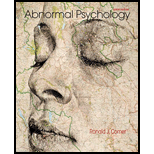
Introduction
Depression or clinical depression is characterized as a severe mood disorder that includes the symptoms of sadness, feelings of worthlessness, loss of interest in the activities that were once enjoyable, sleep disturbance, and feelings of emptiness. However, it is important to note that, at times, everyday sadness can sometimes be mistaken for clinical depression. For correct diagnosis, it is important to know the difference between the two.
Explanation of Solution
Suggested response
Everyone is bound to experience feelings of sadness at some point in their life due to a number of reasons, such as the loss of a loved one, major financial losses, or divorce. However, most of the sad and low feelings triggered by certain stressful events eventually fade. In the case of clinical depression, the feelings of sadness, if left unchecked or untreated, may persist for two weeks or more.
Another factor that differentiates usual sadness from depression is that the latter is more pervasive and causes immense distress to the sufferer. Depression disrupts the person's ability to normally function in professional and personal life.
Common depression symptoms are: sadness or empty feelings, anhedonia, trouble in falling asleep, fatigue, feeling of worthlessness, remarkable weight gain or weight loss, problems in concentrating and making decisions. A person who experiences at least five of these symptoms for more than two weeks is likely to be diagnosed with clinical depression.
Want to see more full solutions like this?
- Summarize key aspects on the buddhism tradition that has impacted your understanding of religious diversity?arrow_forwardwhat important foundational factors and sacred texts and traditions for the buddhism tradition? use 2 scholarly articles properly citedarrow_forwardwhere and how did the buddhist tradition emerge?arrow_forward
- for a drug treatment program what are the prominent theories/models that underlie the service provided. Moral Model, Medical - Disease Model Learning Theory, Psychoanalytic Theory. Ecological Perspective, Family Theory, Bio Psycho Social Theoryarrow_forwardwhat skills or information do you need to improve the quality of your work with Alcohol or drug abuse clients?arrow_forwarddescribe an imaginary/factious treatment agency/program addressing clientele, level of care, curriculum, assessment procedures, treatment plans, case management and counseling issues, staff issues, etcarrow_forward
- Construct an example of a peer evaluation. Instructions: Clarity and coherence of writing Depth of musical analysis Accuracy and relevance of observations Organization and structure of the report Grammar, spelling, and punctuation Originality of workarrow_forwardDraft an example of a peer evaluation. Instructions: Clarity and coherence of writing Depth of musical analysis Accuracy and relevance of observations Organization and structure of the report Grammar, spelling, and punctuation Originality of workarrow_forwardMatch musicians with a style of jazz. Prompts Answers Antonio Carlos Jobim Bossa Nova Tito Puente Latin Jazz Maceo Parker Third Stream Gil Evans Funkarrow_forward
- Write an example of a personal reflection of your course. - What you liked about the course. - What you didn’t like about the course. - Suggestions for improvement. The Reflection Paper should be 1 or 2 pages in length.arrow_forwardHave you experienced a state of flow? If so, please describe what you experienced, and what factors you think contributed to this occurring. If not, discuss what you think might assist you in experiencing flow. Do you believe it is necessary to be in a state of flow to fully engage in creative work; or is it helpful but not strictly necessary? Support your position with your own observationsarrow_forwardThis unit is designed to introduce students to the principles of community psychology and examine local issues through a lens of social determinants of health. Students will explore varieties of community issues such as homelessness, substance abuse, visible and invisible disabilities, and the public health crisis of racism. By analyzing the ways in which SDH intersects with both physical and mental health, both in their own communities and in differing communities, students will understand how social inequities can significantly impact the overall health of a population. Short Description This activity explores how inequality has both physical and psychological impacts on the individual and the community's health. Students will use a step-by-step analysis of SDH around the world. Instructions Using the unit readings, review the Social Determinants of Health: Public Health Agency of Canada. (2020, October 7). Social determinants of health and health and health inequalities. Government…arrow_forward
 Ciccarelli: Psychology_5 (5th Edition)PsychologyISBN:9780134477961Author:Saundra K. Ciccarelli, J. Noland WhitePublisher:PEARSON
Ciccarelli: Psychology_5 (5th Edition)PsychologyISBN:9780134477961Author:Saundra K. Ciccarelli, J. Noland WhitePublisher:PEARSON Cognitive PsychologyPsychologyISBN:9781337408271Author:Goldstein, E. Bruce.Publisher:Cengage Learning,
Cognitive PsychologyPsychologyISBN:9781337408271Author:Goldstein, E. Bruce.Publisher:Cengage Learning, Introduction to Psychology: Gateways to Mind and ...PsychologyISBN:9781337565691Author:Dennis Coon, John O. Mitterer, Tanya S. MartiniPublisher:Cengage Learning
Introduction to Psychology: Gateways to Mind and ...PsychologyISBN:9781337565691Author:Dennis Coon, John O. Mitterer, Tanya S. MartiniPublisher:Cengage Learning Psychology in Your Life (Second Edition)PsychologyISBN:9780393265156Author:Sarah Grison, Michael GazzanigaPublisher:W. W. Norton & Company
Psychology in Your Life (Second Edition)PsychologyISBN:9780393265156Author:Sarah Grison, Michael GazzanigaPublisher:W. W. Norton & Company Cognitive Psychology: Connecting Mind, Research a...PsychologyISBN:9781285763880Author:E. Bruce GoldsteinPublisher:Cengage Learning
Cognitive Psychology: Connecting Mind, Research a...PsychologyISBN:9781285763880Author:E. Bruce GoldsteinPublisher:Cengage Learning Theories of Personality (MindTap Course List)PsychologyISBN:9781305652958Author:Duane P. Schultz, Sydney Ellen SchultzPublisher:Cengage Learning
Theories of Personality (MindTap Course List)PsychologyISBN:9781305652958Author:Duane P. Schultz, Sydney Ellen SchultzPublisher:Cengage Learning





